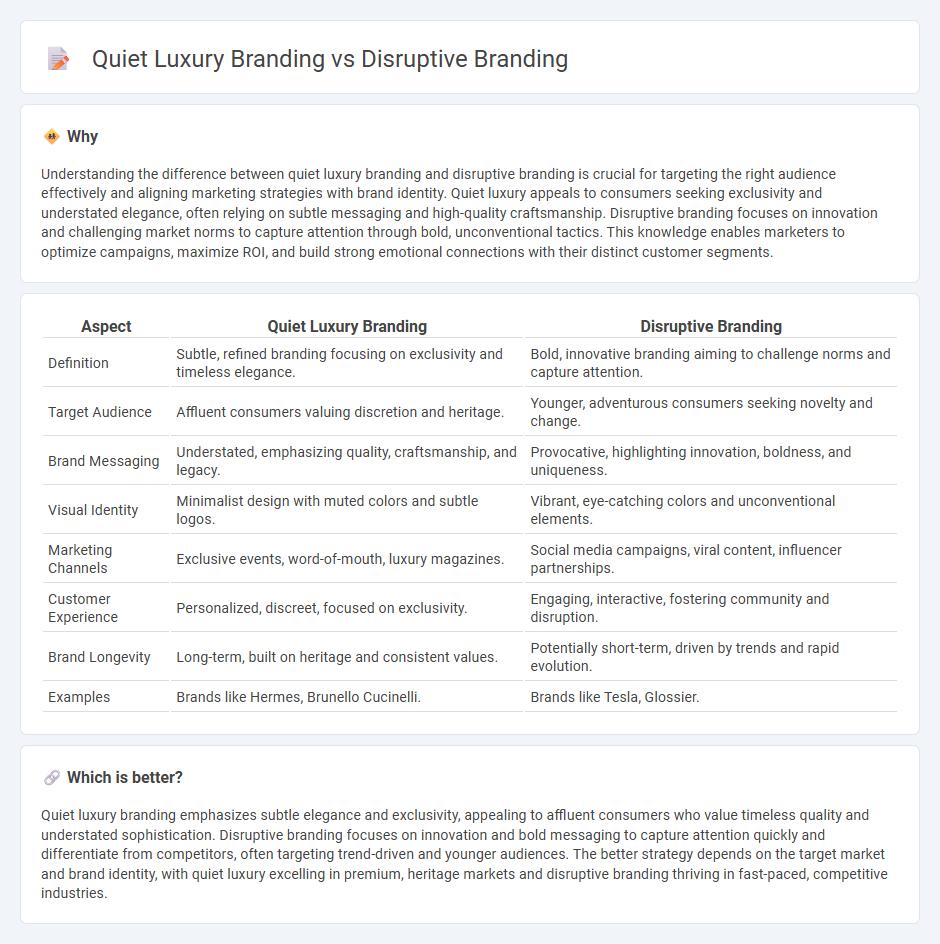
Quiet luxury branding emphasizes subtle elegance, timeless quality, and exclusivity, appealing to discerning consumers seeking understated sophistication. Disruptive branding focuses on innovation, bold messaging, and challenging market norms to capture attention and rapidly expand market share. Explore the key strategies and impacts of both branding approaches to enhance your marketing effectiveness.
Why it is important
Understanding the difference between quiet luxury branding and disruptive branding is crucial for targeting the right audience effectively and aligning marketing strategies with brand identity. Quiet luxury appeals to consumers seeking exclusivity and understated elegance, often relying on subtle messaging and high-quality craftsmanship. Disruptive branding focuses on innovation and challenging market norms to capture attention through bold, unconventional tactics. This knowledge enables marketers to optimize campaigns, maximize ROI, and build strong emotional connections with their distinct customer segments.
Comparison Table
| Aspect | Quiet Luxury Branding | Disruptive Branding |
|---|---|---|
| Definition | Subtle, refined branding focusing on exclusivity and timeless elegance. | Bold, innovative branding aiming to challenge norms and capture attention. |
| Target Audience | Affluent consumers valuing discretion and heritage. | Younger, adventurous consumers seeking novelty and change. |
| Brand Messaging | Understated, emphasizing quality, craftsmanship, and legacy. | Provocative, highlighting innovation, boldness, and uniqueness. |
| Visual Identity | Minimalist design with muted colors and subtle logos. | Vibrant, eye-catching colors and unconventional elements. |
| Marketing Channels | Exclusive events, word-of-mouth, luxury magazines. | Social media campaigns, viral content, influencer partnerships. |
| Customer Experience | Personalized, discreet, focused on exclusivity. | Engaging, interactive, fostering community and disruption. |
| Brand Longevity | Long-term, built on heritage and consistent values. | Potentially short-term, driven by trends and rapid evolution. |
| Examples | Brands like Hermes, Brunello Cucinelli. | Brands like Tesla, Glossier. |
Which is better?
Quiet luxury branding emphasizes subtle elegance and exclusivity, appealing to affluent consumers who value timeless quality and understated sophistication. Disruptive branding focuses on innovation and bold messaging to capture attention quickly and differentiate from competitors, often targeting trend-driven and younger audiences. The better strategy depends on the target market and brand identity, with quiet luxury excelling in premium, heritage markets and disruptive branding thriving in fast-paced, competitive industries.
Connection
Quiet luxury branding emphasizes understated elegance and exclusivity, resonating with high-net-worth consumers seeking authenticity and timeless value. Disruptive branding challenges conventional marketing norms by introducing innovative, bold approaches that capture attention in saturated markets. The connection lies in how disruptive branding techniques can amplify the subtle, refined messaging of quiet luxury to create a powerful, differentiated market presence.
Key Terms
Disruptive Branding:
Disruptive branding challenges traditional market norms by using bold visuals, provocative messaging, and innovative marketing strategies to capture consumer attention and differentiate from competitors. This approach leverages surprise and uniqueness to rapidly build brand recognition and foster strong emotional connections with target audiences. Explore how disruptive branding transforms industries and sparks consumer engagement in today's competitive landscape.
Innovation
Disruptive branding emphasizes bold, innovative strategies that challenge industry norms and capture immediate attention through radical design and messaging. Quiet luxury branding prioritizes subtle innovation, delivering high-quality craftsmanship and timeless elegance that resonate with discerning consumers seeking understated sophistication. Explore how these distinct approaches to innovation shape brand identity and consumer loyalty.
Bold Messaging
Disruptive branding leverages bold messaging that challenges industry norms and captures consumer attention through provocative, high-impact communication. Quiet luxury branding emphasizes understated elegance and subtle sophistication, using minimalist messaging that appeals to exclusivity and refined taste. Explore more to understand which bold messaging strategy aligns best with your brand's identity and market positioning.
Source and External Links
What is a Disruptive Brand and How Can You Become One? - A disruptive brand challenges the status quo and traditional category norms by being unapologetically different, using innovative marketing and product strategies to stand out and attract more customers.
Practical branding: why disruptive isn't always better - Disruptive branding intentionally breaks conventions to focus on underserved markets with bold innovation but can fail if it strays too far from consumer expectations or practical solutions.
What Does it Mean to be a Disruptive Brand? - Salesforce - Disruptive brands look at established industries and deliver distinctive value or do existing things better, moving fast to innovate by leveraging consumer technology to transform market experiences.
 dowidth.com
dowidth.com